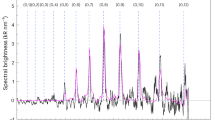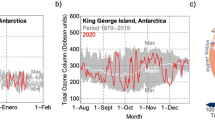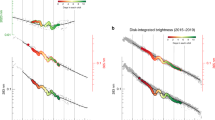Abstract
THE presence of atmospheric ultraviolet (UV) emission between 1,350 and 2,200 Å from the nightside of Venus was first detected by instruments on board the Mariner 5 flyby1. Recently this emission was observed by the UV spectrometer on Pioneer Venus Orbiter at 2,068 Å and identified by Stewart et al.2 as the (0, 0) Cameron band (a3Π-X1Σ) of CO. Their interpretation suggested a significant input of energy into the nightside thermosphere from the interaction of the solar wind with the planet. We report here the preliminary results of observations of the nightside spectrum of Venus made with the International Ultraviolet Explorer (IUE) observatory when Venus was near greatest elongation in January 1979. Three features are clearly seen in the spectra, and the spectral resolution of the instrument is adequate to identify them as bands of the nitric oxide δ(C2Π→X2Π) system rather than as Cameron bands. The δ-bands, present in the Earth's twilight and night time airglow spectra3, are produced by the radiative association of nitrogen and oxygen atoms and indicate a significant population of atomic nitrogen at or below the Venus turbopause.
This is a preview of subscription content, access via your institution
Access options
Subscribe to this journal
Receive 51 print issues and online access
$199.00 per year
only $3.90 per issue
Buy this article
- Purchase on SpringerLink
- Instant access to full article PDF
Prices may be subject to local taxes which are calculated during checkout
Similar content being viewed by others

References
Barth, C. A., Pearce, J. B., Kelly, K. K., Wallace, L. & Fastie, W. G. Science 158, 1675–1678 (1967).
Stewart, A. I., Anderson, D. E., Esposito, L. W. & Barth, C. A. Science 203, 777–779 (1979).
Feldman, P. D. & Takacs, P. Z. Geophys. Res. Lett 1, 169–171 (1974).
Boggess, A. et al. Nature 275, 377–385 (1978); Lane, A. L. et al. Nature 275, 414–415 (1978).
Groth, W., Kley, D. & Schurath, U. J. quant. Spectr. Rad. Transfer 11, 1475–1480 (1971).
Strobel, D. F., Oran, E. S. & Feldman, P. D. J. geophys. Res. 81, 3745–3752 (1976).
Lawrence, G. M., Barth, C. A. & Argabright, V. Science 195, 573–574 (1977).
Niemann, H. B. et al. Science 203, 770–772 (1979).
Author information
Authors and Affiliations
Rights and permissions
About this article
Cite this article
FELDMAN, P., MOOS, H., CLARKE, J. et al. Identification of the UV nightglow from Venus. Nature 279, 221–222 (1979). https://doi.org/10.1038/279221a0
Received:
Accepted:
Issue date:
DOI: https://doi.org/10.1038/279221a0
This article is cited by
-
The legacy of Venus Express: highlights from the first European planetary mission to Venus
The Astronomy and Astrophysics Review (2015)


